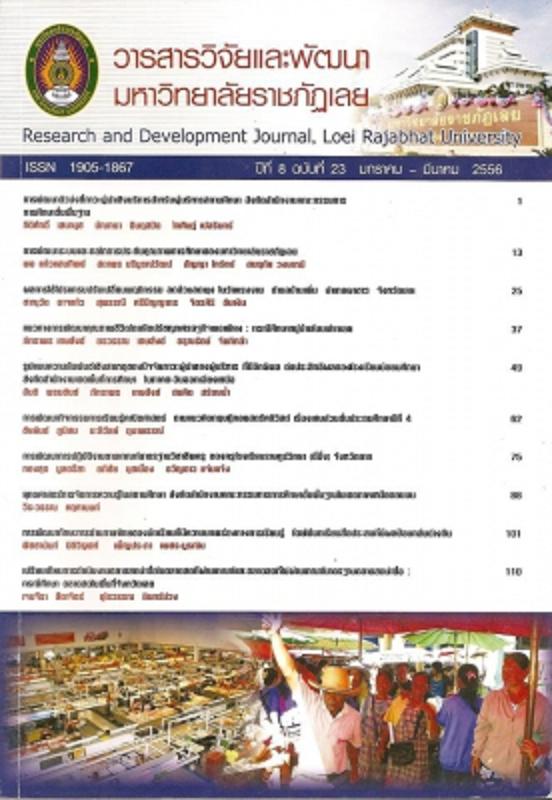การพัฒนาตัวบ่งชี้ภาวะผู้นำเชิงบริการสำหรับผู้บริหารสถานศึกษา สังกัดสำนักงานคณะกรรมการการศึกษาขั้นพื้นฐาน
Keywords:
ตัวบ่งชี้, ภาวะผู้นำเชิงบริการ, สำนักงานคณะกรรมการการศึกษาขั้นพื้นฐาน, indicator, servant leadership, the office of the basic education commissionAbstract
บทคัดย่อ
การวิจัยครั้งนี้มีวัตถุประสงค์เพื่อ 1) พัฒนาตัวบ่งชี้ภาวะผู้นำเชิงบริการสำหรับผู้บริหารสถานศึกษา สังกัดสำนักงานคณะกรรมการการศึกษาขั้นพื้นฐาน และ 2) ทดสอบความสอดคล้องของโมเดลโครงสร้างตัวบ่งชี้ภาวะผู้นำเชิงบริการสำหรับผู้บริหารสถานศึกษากับข้อมูลเชิงประจักษ์ การดำเนินการวิจัยมี 2 ขั้นตอน คือ ขั้นตอนที่ 1 จัดทำตัวบ่งชี้เชิงทฤษฎี โดยการวิเคราะห์เอกสาร และสัมภาษณ์ผู้เชี่ยวชาญ จำนวน 9 คน วิเคราะห์ข้อมูลเชิงคุณภาพด้วยโปรแกรม NVivo 8 แล้วสังเคราะห์เป็นตัวบ่งชี้ภาวะผู้นำเชิงบริการสำหรับผู้บริหารสถานศึกษา และขั้นตอนที่ 2 ทดสอบความสอดคล้องของโมเดลโครงสร้างตัวบ่งชี้ภาวะผู้นำเชิงบริการสำหรับผู้บริหารสถานศึกษากับข้อมูลเชิงประจักษ์ กลุ่มตัวอย่างได้แก่ผู้บริหารสถานศึกษา สังกัดสำนักงานคณะกรรมการการศึกษาขั้นพื้นฐาน จำนวน 574 คน เครื่องมือที่ใช้ในการวิจัยเป็นแบบสอบถามมาตราส่วนประมาณค่า 5 ระดับ วิเคราะห์ข้อมูลด้วยโปรแกรมคอมพิวเตอร์สำเร็จรูป เพื่อหาค่าเฉลี่ย ค่าส่วนเบี่ยงเบนมาตรฐาน ค่าสถิติเพื่อพิจารณาความเหมาะสมของข้อมูล และใช้โปรแกรม LISREL วิเคราะห์องค์ประกอบและตรวจสอบความสอดคล้องกลมกลืนของโมเดลที่พัฒนาขึ้นกับข้อมูลเชิงประจักษ์
ผลการวิจัยสรุปได้ ดังนี้
1. ตัวบ่งชี้ภาวะผู้นำเชิงบริการสำหรับผู้บริหารสถานศึกษา สังกัดสำนักงานคณะกรรมการการศึกษาขั้นพื้นฐาน ประกอบด้วย 10 องค์ประกอบหลัก 24 องค์ประกอบย่อย 82 ตัวบ่งชี้ ได้แก่ 1) ด้านการรับฟัง มี 3 องค์ประกอบย่อย 10 ตัวบ่งชี้ 2) ด้านการเอาใจเขามาใส่ใจเรา มี 3 องค์ประกอบย่อย 9 ตัวบ่งชี้ 3) ด้านการแก้ไข มี 2 องค์ประกอบย่อย 7 ตัวบ่งชี้ 4) ด้านการตระหนักรู้ มี 3 องค์ประกอบย่อย 11 ตัวบ่งชี้ 5) ด้านการโน้มน้าวใจ มี 2 องค์ประกอบย่อย 8 ตัวบ่งชี้ 6) ด้านการสร้างมโนทัศน์ มี 2 องค์ประกอบย่อย 6 ตัวบ่งชี้ 7) ด้านการมองการณ์ไกล มี 3 องค์ประกอบย่อย 10 ตัวบ่งชี้ 8) ด้านการเป็นผู้ดูแล มี 2 องค์ประกอบย่อย 7 ตัวบ่งชี้ 9) ด้านการอุทิศตนเพื่อพัฒนาคน มี 2 องค์ประกอบย่อย 7 ตัวบ่งชี้และ 10) ด้านการสร้างชุมชน มี 2 องค์ประกอบย่อย 7 ตัวบ่งชี้
2. ผลการตรวจสอบความสอดคล้องของโมเดลการวิเคราะห์องค์ประกอบเชิงยืนยันของตัวบ่งชี้ พิจารณาจากค่าสถิติดังนี้ คือ c2 = 198.11 df = 190 p-value = .328 c2/df = 1.042 GFI = .97 AGFI = 0.95 CFI = 1.00 Standardized RMR = 0.039 RMSEA = 0.009 และ Critical N = 615.93 โมเดลที่พัฒนาขึ้นมีความสอดคล้องกลมกลืนกับข้อมูลเชิงประจักษ์เป็นไปตามสมมติฐาน
Abstract
This study was designed : 1) to develop the servant leadership indicators for principals in schools under the Office of the Basic Education Commission, and 2) to test the goodness of fit for the structural model indicators with the empirical data.
There were two phases in this study. Phase one was the theoretical indicators construction which documentary analysis and the interviews with 9 experts were applied for qualitative data. The earned data were analyzed by Nvivo 8 program then synthesized the data for the servant leadership indicators. Phase two was the test of the structural model’s goodness of fit with the empirical data.
The samples were 574 school principals drawn from the schools under the Office of the Basic Education Commission. The research instruments for data gathering consisted of an interview and a 5-point rating scale questionnaire. The SPSS for Windows 11.5 was applied for quantitative data analysis to obtain mean, standard deviation then Bartlett test of Sphericity and measure of sampling adequacy (MSA) were used for the appropriateness of the data for factor analysis. LISREL program was used for confirmation factor analysis and checking the consistency of developed model and the empirical data.
The findings of this study were summarized as follows :
1. The results of the indicator formation and development were found that the servant leadership indicators were classified into 10 core factors, 24 sub factors and 82 indicators. They were listening with 3 sub factors and 10 indicators ; empathy with 3 sub factors and 9 indicators ; correction with 2 sub factors and 7 indicators ; awareness with 3 sub factors and 11 indicators; persuasion with 2 sub factors and 8 indicators; conceptualization with 2 sub factors and 6 indicators; foresight with 3 sub factors and 10 indicators; stewardship with 2 sub factors and 7 indicators; commitment to the growth of people with 2 sub factors and 7 indicators and the last one was the community building with 2 sub factors and 7 indicators.
2. The goodness of fit test of the indicators’ confirmatory factor analysis model was found that the models were fit to the empirical data following the hypotheses and based on the statistics as follows : c2 = 198.11, df =190, p-value =. 328, c2/df = 1.042, GFI = 0.97, AGFI = 0.95, CFI = 1.00, Standardized RMR = 0.039, RMSEA = 0.009 and Critical N = 615.93.
Downloads
How to Cite
Issue
Section
License
ข้อความที่ปรากฎในวารสารฉบับนี้เป็นความคิดเห็นของผู้เขียนแต่ละท่าน สถาบันวิจัยและพัฒนา มหาวิทยาลัยราชภัฏเลย และกองบรรณาธิการ ไม่จำเป็นต้องเห็นด้วยและไม่มีส่วนรับผิดชอบใดๆ
สถาบันวิจัยและพัฒนา มหาวิทยาลัยราชภัฏเลย ขอให้ผู้อ่านอ้างอิงในกรณีที่ท่านคัดลอกเนื้อหาบทความในวารสารฉบับนี้






